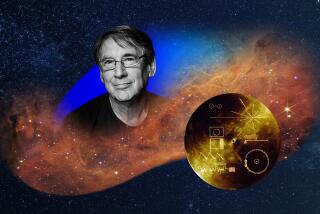A Cosmos for Humans
- Share via
The Babylonians rendered the world on clay tablets as long ago as 2300 BC, and many 16th century depictions of the Earth are so colorful and elaborate that they are considered masterworks. But arguably the most mind-bending map to date is the cosmic survey released last week by Princeton University astrophysics professor J. Richard Gott III.
Based on a snapshot of the sky taken Aug. 12, the map depicts an imaginary journey away from Earth. First encounter: man-made objects like the Chandra X-ray observatory, as well as several other satellites designed in Southern California. Then it’s off to Proxima Centauri, the nearest star at a mere 155,000 years away at space-shuttle speed, and a skate by a wall of galaxies 1.37 billion light-years long. Finally, Gott goes to the most distant known galaxy, 155,000 billion billion miles away.
New Scientist, the British journal that published Gott’s fold-out map in its Nov. 22 issue, deems it “a stunning achievement.” The journal may be hyping the import of its exclusive story, of course. No one, however, can deny that Gott has taken the rich fount of information that cheap robot probes have beamed to Earth since the 1970s and assembled it in an ingeniously helpful way.
Gott realized that if he shrank the enormous distances in the cosmos to fit on a single page, then he would have to depict the entire Milky Way galaxy as a dot smaller than a dust speck.
Conversely, if he made our galaxy fit the page, then he’d need 62 miles of paper to show the most distant object. So he decided to plot objects on a scale, exaggerating those nearby and shrinking those far away using a mathematical means that, if nothing else, manages to accurately depict relative distances.
That might sound like cheating, an affront to the objective science that we think should guide mapmaking. In fact, however, the cartographers that historians have singled out as great tend to be more artists than scientists, more popularizers than robot-like image drawers.
The famous projection of the Earth by the 16th century’s Gerardus Mercator, for instance, accurately renders shapes of continents but distorts their areas. Mercator, in other words, knew he was making his map not for penguins but for humans -- from kings to seafaring colonizers.
Subjectivity similarly skews Gott’s map, but that’s why it’s so useful. Doing something arguably more valuable than photography, it helps mere mortals envision concepts once fathomable only to physics prodigies.
View the map at: www.astro.princeton.edu/~mjuric/universe/






